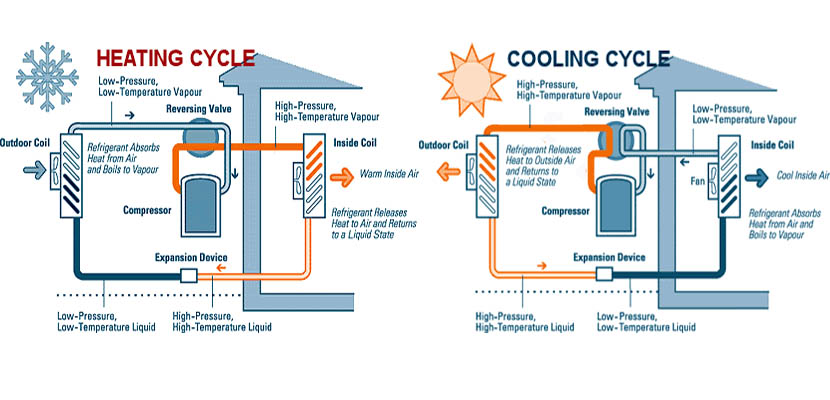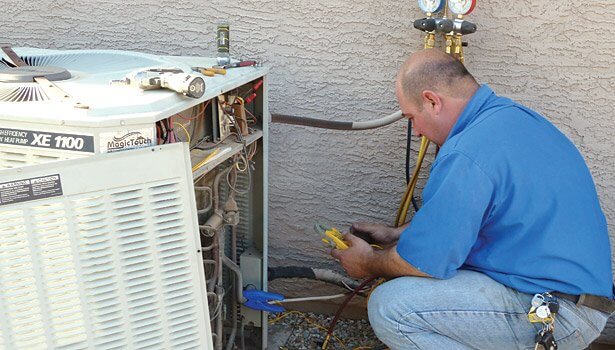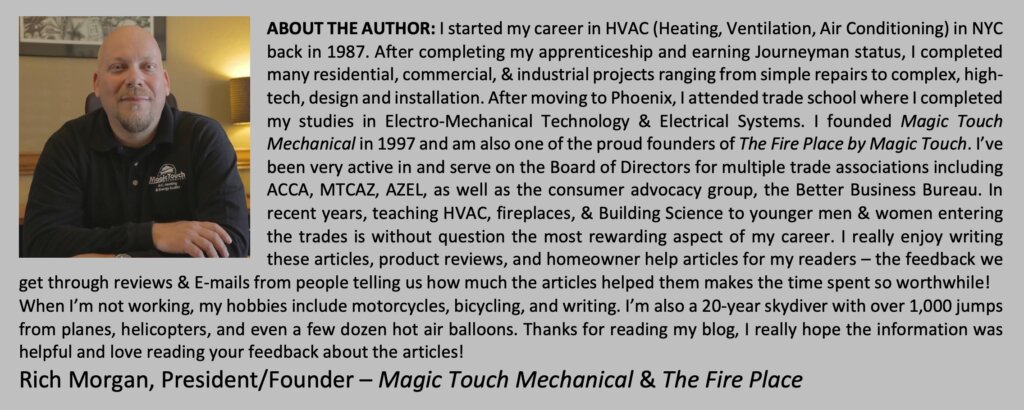Heat Pump Defrost Cycle
Understanding the heat pump defrost cycle and how it works is something every heat pump owner should know. This article explains what a heat pump defrost cycle is, how often it occurs, and how long it should last. When you’re familiar with how your heat pump works, you’ll know when it’s operating the way it’s supposed to. More importantly, you’ll know when your heat pump is not behaving normally, and when you need to call for service.

What is the Heat Pump Defrost Cycle?
In my article, How Does a Heat Pump Work, I explained; heat pumps reverse the AC cycle in heating mode. Check out that article for a more in-depth explanation of heat pump operation.
To summarize the article, a component called a reversing valve changes the direction of refrigerant flow. In doing so, when a heat pump is operation in heating, the outdoor unit (condenser) is expelling cold air. Placing your hand in the airstream above the outdoor fan, you’ll feel much colder air than the outdoor ambient temperature.
Moisture in the cold air will eventually accumulate on the already cold coils and begin to develop into frost. Left unchecked, the frost would continue to build and form a layer of ice over the coil. A heat pump needs air to easily flow through the outdoor coils to transfer heat into your home. The heat pump defrost cycle is designed to remove frost before ice develops and impedes airflow across the outdoor coil.

Heat Pumps Use a Temperature Sensor to Initiate the Defrost Cycle
Modern heat pumps use electronic temperature sensors to determine when the defrost cycle should begin. The homeowner does not need to do anything to initiate the defrost cycle as the heat pump does everything automatically.
Each manufacturer has specific conditions that trigger the heat pump defrost cycle and how long it lasts. Below are a few examples to demonstrate the differences.
- Bosch heat pump defrost cycle begins when the temperature sensor indicates the coil is below 62°F. The defrost cycle on their heat pumps is designed to run & complete in 11 minutes.
- Lennox package heat pumps operate a little differently. Lennox chooses to use an older heat pump defrost cycle method known as time & temperature. Rather than just rely on the coil temperature, Lennox heat pumps also “check” the temperature at specific time intervals. If the coil temperature is below 58°F at the time it’s checked, the defrost cycle begins. The cycle lasts approximately 20 minutes in extreme frost conditions.
- The heat pump defrost cycle on Gree brand heat pumps runs for 16 minutes.
As you can see by the examples above, every manufacturer has engineered the defrost cycle conditions specific to their equipment.
How Long Does a Heat Pump Defrost Cycle Last?
In general, the heat pump defrost cycle should last anywhere between 10 to 20 minutes at most. On average, the typical heat pump defrost cycle will run closer to 12 minutes on most machines.
How Often Does a Heat Pump Run in Defrost?
As we discussed in the examples above, every manufacturer is engineered differently. Each brand determines what conditions initiate the defrost cycle. In general, you should expect your heat pump to defrost once or twice per hour on extremely cold days. On moderately cold days, your heat pump may only initiate a defrost cycle every 60 to 120 minutes.
Depending on your location, you may notice the heat pump defrost cycle tends to happen only after dark. Here in Phoenix, we tend to see heat pumps defrosting in the middle of the night and right before dawn.
Magic Touch customer service representatives are flooded with phone calls every winter – especially on the 1st very cold day. Homeowners not familiar with the heat pump defrost cycle works think their unit stopped working and call for service. Our CSRs are trained to inform them the unit may just be defrosting which is normal operation. If the unit is still not heating after 30 minutes, we schedule a service call knowing there’s indeed another problem.
Is There Anything I Can Check Myself?
Yes, you can verify if your heat pump is in the defrost cycle by looking at the condenser unit (outside). If you can hear the compressor running but the outdoor fan isn’t turning, it is in defrost (typically). You may even see steam coming of the grill on top of the unit above the fan. Lastly, if you can see the coils through the coil guard grills, you may even see the frost melting.
If you have a rooftop unit you can’t see from the ground, I recommend you wait it out. If there’s frost on your heat pump, there’s likely frost on your roof too. The last thing you want is to slip on your roof when you can just wait 30 minutes. If the unit hasn’t started heating in 30 minutes, you know it’s time to schedule a service call.
Check your thermostat. Some modern thermostats will display a message when the heat pump is in defrost.
Heat Pump Thermostat Defrost Issues
Depending on the thermostat and the heat pump brand / model, electronic “conflicts” can arise. In most cases, it’s best to let the heat pump itself control the defrost cycle not the thermostat.
Ecobee Defrost Control Settings
Just recently, Magic Touch technicians found a defrost conflict with a little-known setting in Ecobee thermostats. Both the thermostat and the unit were sending conflicting messages to the defrost control board. Neither the Ecobee manual nor the equipment manual mentioned this, and we found it purely accidentally. I wrote the article, Ecobee Thermostat Heat Pump Setting with step-by-step instructions to change the thermostat setting and resolve the issue.
If your thermostat has settings to control your heat pump defrost cycle, it may need to be turned off. Of course, it may be intentionally set it that way, so I recommend consulting a local pro before making changes.

Other Common Failures
There are a few common failures that will cause your heat pump not to defrost as designed. All these issues will require an experienced heat pump technician to diagnose and repair. Common heat pump defrost cycle failures include:
- Faulty defrost control board.
- Faulty defrost temperature sensor.
- Low voltage wiring problems.
- Thermostat or thermostat sub-base problems.
- Low refrigerant charge.
- Dirty condenser coils.
Planning for Comfort
If you plan properly, you can keep your house comfortable and avoid longer periods of defrost. While we all know our local weatherman isn’t always right, we usually know when it’s going to get very cold. A few changes to your thermostat settings ahead of time will help keep you, your family, and pets comfortable.
- If you use a programmable thermostat schedule, set it to a comfortable setting an hour or more before you wake. This allows your heat pump to initiate defrost while you’re still under the covers, so it’s back in heating mode when you get out of bed.
- Don’t turn off your heat completely overnight. A lot of us (me included) like it chilly when we sleep and only turn heat on in the morning. The problem with this is the coil temperature is going to be the ambient temperature when the heat pump starts. If your coil temperature is already below the defrost threshold, it will go into defrost rather quickly.
Install Strip Heat in Your Heat Pump
- Consider adding resistance heat aka electric strip heat. Almost all heat pump manufacturers provide an option to add electric strip heat. Strip heat is designed to kick in and heat your home while the heat pump is in defrost. The downside to resistance heat is the high cost to operate – it’s the most expensive way to heat your home. However, when used to provide heating only during defrost cycles, it won’t run often enough to drain your bank account.
NOTE: Electric strip heat typically requires the addition of an independent electric circuit from your breaker box (fuse panel). The cost to add a new electrical circuit depends on your home’s configuration, panel and unit location, and other variables. Installation costs can vary widely from a few hundred dollars to a few thousand dollars for complicated installations.
Magic Touch Mechanical
Email: Info@MagicTouchAir.com



There's Magic in the Air! AC, Heat, Fireplaces & Fire Pits since 1997 Article Author: Rich Morgan, CEO - Magic Touch